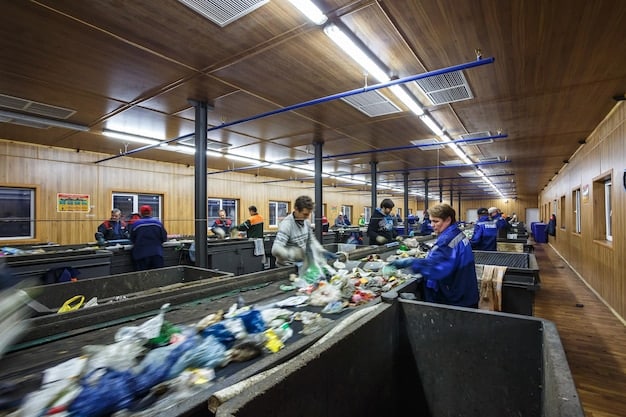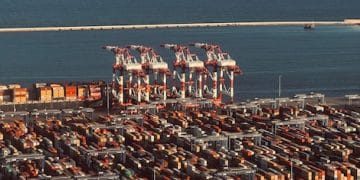Climate Change Strategies: How US Businesses Adapt

US businesses are proactively preparing for climate change impacts by implementing strategies such as enhancing infrastructure resilience, adopting sustainable practices, and integrating climate risk assessments into their operational planning.
As the climate continues to change, how are US businesses preparing for the potential impact of climate change on their operations? Many are recognizing the need to adapt to ensure long-term sustainability and resilience. Let’s delve into the specific strategies and measures they are adopting.
Understanding the Climate Change Risks Faced by US Businesses
Climate change presents a multifaceted challenge to businesses across the United States. The immediate and long-term risks range from direct physical impacts to broader economic consequences. Understanding these risks is the first step in effective preparation.
Physical Risks: Direct Impacts on Operations
Physical risks are the most tangible and immediate effects of climate change. These include damage to infrastructure, disruptions to supply chains, and increased operational costs.
- Extreme Weather Events: More frequent and intense hurricanes, floods, and wildfires can directly damage business premises and equipment.
- Sea-Level Rise: Coastal businesses face inundation and erosion, threatening property and access.
- Water Scarcity: Businesses reliant on water resources may experience shortages, impacting production and operations.
For example, companies in coastal Florida are investing in reinforced buildings and flood barriers to protect against rising sea levels and storm surges. Similarly, agricultural businesses in California are implementing water-efficient irrigation techniques to cope with prolonged droughts.

Economic and Market Risks: Indirect Consequences
Economic and market risks are less direct but equally significant. These include changes in consumer behavior, increased regulatory pressures, and shifts in market demand.
- Supply Chain Disruptions: Extreme weather events can disrupt supply chains, leading to material shortages and increased costs.
- Increased Insurance Costs: Insurers are raising premiums or withdrawing coverage in high-risk areas, increasing operational expenses.
- Changing Consumer Preferences: Consumers are increasingly favoring sustainable products and services, requiring businesses to adapt.
Many businesses are now conducting climate risk assessments to understand their exposure to these economic and market risks. This helps them make informed decisions about investments, operations, and strategic planning.
In summary, US businesses face a wide range of climate change risks, from direct physical impacts to indirect economic consequences. Recognizing and understanding these risks is crucial for developing effective adaptation strategies.
Enhancing Infrastructure Resilience to Climate Change
One of the primary ways US businesses are preparing for climate change is by enhancing the resilience of their infrastructure. This includes investing in upgrades, retrofits, and new technologies to withstand the impacts of extreme weather events and changing environmental conditions.
Investing in Climate-Resilient Infrastructure
Building resilience into infrastructure involves more than just repairing existing systems. It requires a proactive approach to design and construction that considers future climate scenarios.
- Reinforced Buildings: Constructing buildings that can withstand stronger winds, heavier rainfall, and higher temperatures.
- Flood Protection: Implementing measures such as levees, floodwalls, and elevation to protect against rising water levels.
- Water Management Systems: Investing in efficient irrigation, water storage, and drainage systems to manage water resources effectively.
For instance, companies in Houston, Texas, are raising the elevation of critical infrastructure and improving drainage systems to mitigate the impact of severe flooding. Retail businesses are also relocating facilities away from flood-prone areas.
Adopting Green Infrastructure Solutions
Green infrastructure offers a nature-based approach to enhancing resilience. These solutions use natural ecosystems and processes to manage climate risks while providing additional benefits.
- Green Roofs: Reducing stormwater runoff, improving energy efficiency, and providing habitat for wildlife.
- Urban Forests: Providing shade, reducing the urban heat island effect, and absorbing stormwater.
- Wetland Restoration: Protecting shorelines, absorbing floodwaters, and improving water quality.
Cities like New York are investing in green infrastructure projects to manage stormwater and reduce the risk of flooding. These projects not only enhance resilience but also improve the quality of life for residents.
In conclusion, enhancing infrastructure resilience is a critical component of climate change preparation for US businesses. By investing in climate-resilient infrastructure and adopting green infrastructure solutions, businesses can protect their assets and operations from the impacts of climate change.
Integrating Sustainable Practices into Business Operations
Another key strategy for US businesses is integrating sustainable practices into their day-to-day operations. This involves adopting environmentally friendly processes, reducing resource consumption, and minimizing waste.
Reducing Carbon Footprint and Emissions
Reducing carbon emissions is a crucial step in mitigating climate change. Businesses can achieve this by implementing energy-efficient technologies and transitioning to renewable energy sources.
- Energy Efficiency: Upgrading to energy-efficient lighting, HVAC systems, and equipment to reduce energy consumption.
- Renewable Energy: Investing in solar, wind, and other renewable energy sources to power operations.
- Carbon Offsetting: Purchasing carbon credits to offset emissions from unavoidable activities, such as air travel.
Companies like Apple and Google have committed to powering their operations with 100% renewable energy. They use a combination of on-site solar installations and power purchase agreements to achieve their goals.
Waste Reduction and Recycling Programs
Effective waste management is another essential sustainable practice. Businesses can reduce waste by implementing recycling programs, reducing packaging, and promoting reuse.
- Recycling Programs: Establishing comprehensive recycling programs for paper, plastics, and other materials.
- Reducing Packaging: Minimizing packaging materials and using eco-friendly alternatives.
- Promoting Reuse: Encouraging employees and customers to reuse products and materials whenever possible.

Walmart, for example, has implemented a zero-waste program that aims to eliminate waste sent to landfills through recycling and waste reduction initiatives.
In summary, integrating sustainable practices into business operations is essential for reducing environmental impact and enhancing long-term sustainability. By reducing their carbon footprint and implementing effective waste management programs, businesses can contribute to a cleaner, more sustainable future.
Incorporating Climate Risk Assessments into Strategic Planning
A proactive approach to climate change involves incorporating climate risk assessments into strategic planning. This allows businesses to identify potential vulnerabilities and develop strategies to mitigate these risks.
Identifying Climate-Related Risks and Opportunities
Climate risk assessments help businesses understand the specific risks and opportunities that climate change presents to their operations. This involves analyzing potential impacts on supply chains, infrastructure, and markets.
An analysis may cover potential disruptions to supply chains due to extreme weather events, increases in energy costs due to regulatory changes, or shifts in consumer demand toward more sustainable products.
For example, a food processing company might assess the impact of prolonged droughts on crop yields and develop strategies to diversify its sourcing to mitigate supply chain disruptions.
Developing Adaptation and Mitigation Strategies
Once risks and opportunities are identified, businesses can develop strategies to adapt to changing conditions and mitigate their impact on the environment. This includes investments in infrastructure, technology, and sustainable practices.
- Adaptation Strategies: Implementing measures to reduce vulnerability to climate impacts, such as reinforcing infrastructure and diversifying supply chains.
- Mitigation Strategies: Reducing greenhouse gas emissions and minimizing environmental impact through energy efficiency and renewable energy investments.
Businesses should also develop contingency plans to ensure they can continue operations in the face of unexpected climate events.
In conclusion, incorporating climate risk assessments into strategic planning is essential for making informed decisions and ensuring long-term resilience. By identifying risks and opportunities and developing proactive strategies, businesses can adapt to climate change and minimize their environmental impact.
Collaborating with Stakeholders and Sharing Best Practices
Addressing climate change effectively requires collaboration among businesses, governments, and other stakeholders. Sharing best practices and working together can accelerate the adoption of sustainable solutions.
Engaging with Governments and Industry Associations
Collaboration with government agencies and industry associations can provide businesses with access to resources, expertise, and policy guidance. This can help them stay informed about regulatory changes and best practices.
Industry associations can provide a platform for businesses to share experiences and learn from each other, accelerating the adoption of sustainable practices.
Governments can offer incentives and support for businesses that implement climate-friendly initiatives, encouraging broader adoption.
Sharing Knowledge and Resources with Peers
Sharing knowledge and resources with peers can help businesses learn from each other’s successes and failures. This can lead to more effective and efficient climate action.
- Open-Source Platforms: Contributing to open-source platforms and sharing data and best practices with the broader business community.
- Mentorship Programs: Establishing mentorship programs to help smaller businesses implement sustainable practices.
By working together, businesses can create a more resilient and sustainable economy.
In summary, collaboration with stakeholders and sharing best practices are essential for accelerating climate action. By engaging with governments, industry associations, and peers, businesses can learn from each other and implement more effective sustainability strategies.
The Role of Policy and Incentives in Driving Climate Action
Government policies and incentives play a crucial role in driving climate action among US businesses. These policies can create a level playing field and encourage businesses to invest in sustainable practices.
Government Regulations and Standards
Government regulations and standards can set clear expectations for environmental performance and encourage businesses to adopt sustainable practices through the threat of penalties or fines.
- Emissions Standards: Setting limits on greenhouse gas emissions from industrial facilities and transportation.
- Energy Efficiency Standards: Establishing minimum energy efficiency standards for buildings and appliances.
- Disclosure Requirements: Requiring companies to disclose their climate-related risks and emissions.
California has been a leader in implementing these types of regulations in the US.
Incentives and Financial Support
Incentives and financial support can make it more economically attractive for businesses to invest in sustainable practices and invest in environmentally beneficial infrastructures.
- Tax Credits: Offering tax credits for investments in renewable energy, energy efficiency, and green infrastructure.
- Grants and Loans: Providing grants and low-interest loans for sustainable projects.
The Inflation Reduction Act of 2022 includes significant incentives for businesses to invest in renewable energy and energy efficiency, the effects of which are sure to compound into the 2030’s.
In conclusion, government policies and incentives are essential for driving climate action among US businesses. By setting clear expectations and providing financial support, governments can encourage businesses to invest in sustainable practices and contribute to a low-carbon economy.
| Key Point | Brief Description |
|---|---|
| 🌊 Infrastructure Resilience | Upgrading facilities to withstand extreme weather and sea-level rise. |
| ♻️ Sustainable Practices | Reducing carbon emissions and waste through energy efficiency and recycling. |
| 📊 Risk Assessments | Identifying climate-related risks and opportunities for strategic planning. |
| 🤝 Collaboration | Working with stakeholders to share knowledge and implement best practices. |
FAQ
▼
The main risks include physical damage from extreme weather, supply chain disruptions, higher operational costs, and changing consumer behaviors.
▼
Businesses can invest in reinforced buildings, flood protection measures, and efficient water management systems to ensure the future functioning of their infrastructure.
▼
Reducing carbon emissions through energy efficiency, transitioning to renewable energy, and minimizing waste via recycling programs are good starting points.
▼
These assessments help businesses identify vulnerabilities, develop adaptation strategies, and make informed decisions about investments and operations.
▼
Government regulations and incentives encourage businesses to invest in sustainable practices. Standards establish clear rules and expectations for these practices.
Conclusion
In conclusion, US businesses are taking proactive steps to prepare for the potential impacts of climate change on their operations, and are increasingly seeing government policies and incentives that can shape how they prepare. By enhancing infrastructure resilience, integrating sustainable practices, and incorporating climate risk assessments into strategic planning, businesses can adapt to changing conditions and contribute to a more resilient and sustainable future.





